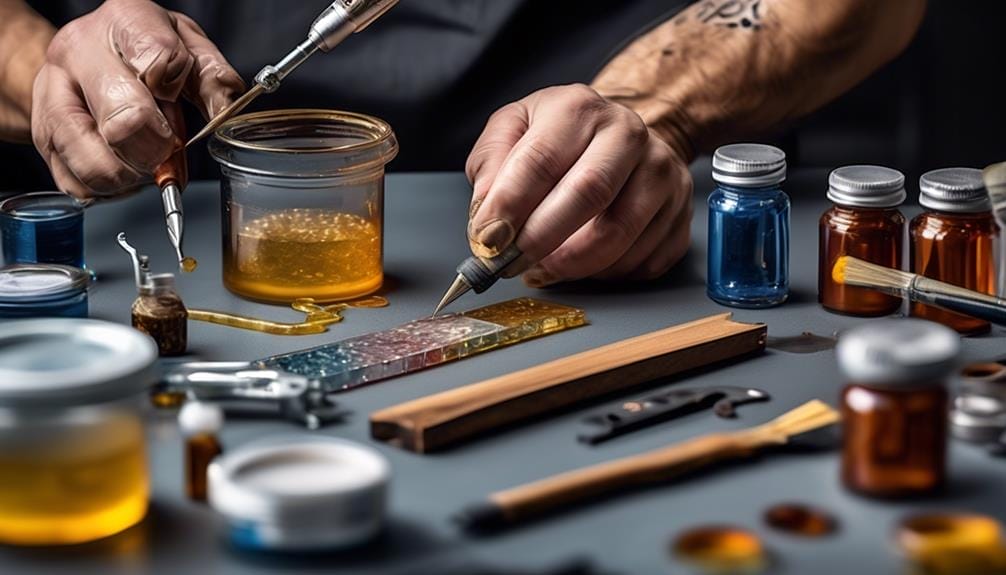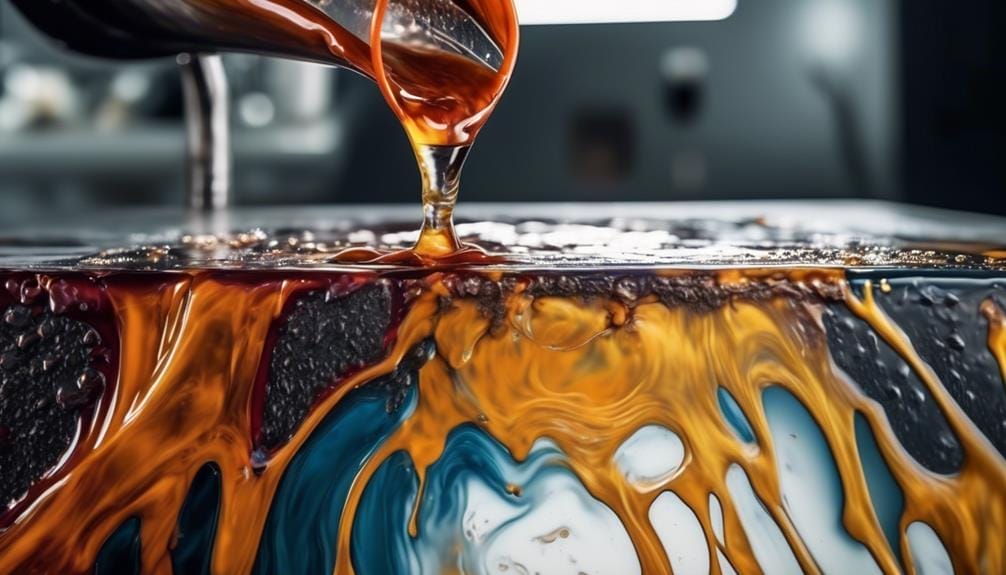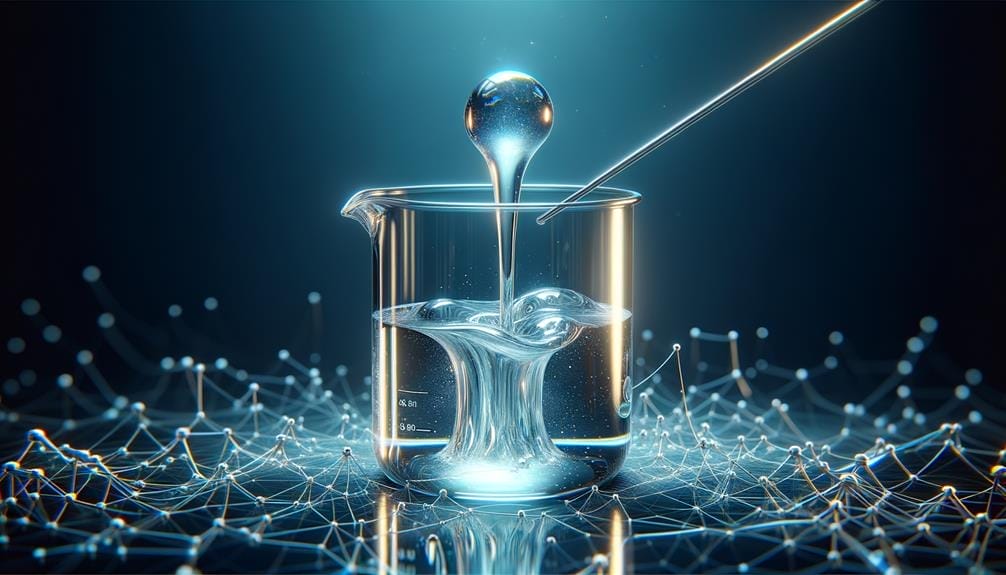Like a hidden key that unlocks the secrets of liquid glass epoxy, understanding its viscosity holds power to reveal the inner workings of this remarkable material. The way it flows spreads and adheres is all determined by its viscosity, a measure of its resistance to flow.
But what factors influence this crucial property? How can it be adjusted for different applications? And what techniques and instruments are used to measure it?
In this discussion, you will uncover the answers to these questions and more, gaining a deeper understanding of the fascinating world of viscosity in liquid glass epoxy.
Key Takeaways
- Viscosity is a crucial factor in determining the behavior and suitability of liquid glass epoxy for different applications.
- Adjusting viscosity can be done through temperature and degree of cure adjustments, as well as the use of resin fillers and solvents.
- Flow characteristics and viscosity are closely related, and measuring viscosity accurately is important for understanding the behavior and performance of liquid glass epoxy.
- Liquid glass epoxy with low viscosity is advantageous for encapsulation, adhesive bonding, and glob top coatings. In contrast, high viscosity epoxy is ideal for precise placement, gap filling, and exceptional strength and durability. These epoxies find applications in various industries, such as electronics, aerospace, medical devices, automotive, and construction.
Importance of Viscosity in Liquid Glass Epoxy
Understanding the importance of viscosity in liquid glass epoxy is essential for optimizing its performance and application methods. Viscosity refers to the resistance of a liquid to flow. In the case of liquid glass epoxy, viscosity plays a crucial role in determining how the material behaves and can greatly impact its suitability for different applications.
One important aspect to consider is the range of viscosities available in liquid glass epoxy. This range includes low-viscosity systems, which have a thinner consistency and flow more easily, as well as high-viscosity systems, which are thicker and flow less readily. These different viscosities cater to various application needs.
For example, low-viscosity epoxy is often used for applications such as bonding, where it needs to penetrate small gaps or crevices. On the other hand, high-viscosity epoxy is commonly used for applications like potting or coating, where a thicker material is required for better adhesion and protection.
Understanding the role of viscosity is also crucial for optimizing application methods. For instance, in the case of bonding, a low-viscosity epoxy can be applied using capillary flow, where the liquid is drawn into the bond line by capillary action. This ensures efficient and uniform coverage. Additionally, the viscosity of the epoxy also affects the bond line thickness, which can impact the overall strength and durability of the bond.
Factors Affecting Viscosity in Epoxy Systems
Temperature, degree of cure, addition of resin fillers and tougheners, and use of solvents are all factors that can affect the viscosity of epoxy systems. Viscosity refers to the resistance of a fluid to flow and is an essential property to consider when working with epoxy resins. Understanding the factors that influence viscosity is crucial for achieving the desired application and performance.
The table below highlights the main factors affecting viscosity in epoxy systems:
| Factor | Effect |
|---|---|
| Temperature | Higher temperatures decrease the viscosity |
| Degree of cure | Increased cure leads to higher viscosity |
| Addition of fillers | Increases viscosity |
| Addition of tougheners | Can increase or decrease the viscosity |
| Use of solvents | Reduces viscosity |
Temperature plays a significant role in epoxy viscosity. As the temperature increases, the epoxy resin becomes less dense, allowing for easier mixing and application. The degree of cure also affects viscosity, with higher levels of cure resulting in higher viscosity. Adding resin fillers increases the viscosity, making the epoxy thicker and more suitable for applications where gap filling or structural support is required. The addition of tougheners can either increase or decrease viscosity depending on the specific toughener used. Lastly, the use of solvents can reduce the viscosity of epoxy systems, making them more fluid and easier to apply.
Adjusting Viscosity for Different Applications

To optimize the viscosity of epoxy for different applications, it’s important to consider factors such as temperature, degree of cure, resin fillers, and solvents. These factors play a crucial role in determining the resistance to flow of the epoxy, ensuring that it’s suitable for the specific application at hand.
Here are three key considerations for adjusting viscosity in epoxy systems:
- Temperature: The viscosity of epoxy is highly dependent on temperature. As the temperature increases, the viscosity decreases, making the epoxy more fluid. It’s important to adjust the temperature during the mixing and application process to achieve the desired viscosity for the specific application.
- Degree of Cure: The degree of cure refers to the extent to which the epoxy has reacted and crosslinked. A higher degree of cure results in a higher viscosity, while a lower degree of cure leads to a lower viscosity. Adjusting the cure time and temperature can help achieve the desired viscosity for different applications.
- Resin Fillers and Solvents: The addition of resin fillers and solvents can significantly impact the viscosity of epoxy. Resin fillers increase the viscosity and can be used to tailor the epoxy for specific applications that require higher viscosity. Solvents, on the other hand, decrease the viscosity and can be used to adjust the flow characteristics of the epoxy.
Understanding Flow Characteristics in Liquid Glass Epoxy
Analyzing the flow characteristics of liquid glass epoxy provides essential insights into its behavior and performance. By understanding how epoxy flows, you can determine its suitability for different applications and optimize its performance.
The viscosity of liquid glass epoxy plays a crucial role in its flow characteristics. The Brookfield viscometer is commonly used to determine the viscosity of liquid glass epoxy. This instrument measures the resistance to the flow of the epoxy and provides valuable information for selecting the appropriate application methods. The viscosity of epoxy resin compounds can vary, ranging from low to moderate to high, depending on the specific application requirements.
Capillary flow is an important aspect of epoxy adhesives. It refers to the ability of the epoxy to flow into tight spaces and create a strong bond. Understanding the flow characteristics of liquid glass epoxy helps in determining the bond line thickness, which is crucial for achieving optimal adhesive strength.
Another important factor to consider is the glass transition temperature (Tg) of the epoxy. By optimizing the Tg, you can enhance the flow characteristics and performance of the epoxy.
It’s important to note that different epoxy resins may have different flow characteristics, and understanding these characteristics is essential for ensuring the quality and suitability of the epoxy for specific applications.
Measuring Viscosity: Techniques and Instruments

To measure viscosity accurately, you need to employ specific techniques and instruments.
Commonly used is the Brookfield viscometer, which determines viscosity based on shear rate, time, and temperature. This viscometer comes in different types to cater to various viscosity testing needs.
Other methods, such as orifice-type, vibrational, rotational, capillary, tube, and falling sphere viscometers, can also be utilized to measure viscosity.
Viscosity Measurement Techniques
Viscosity measurement techniques play a crucial role in accurately determining the flow properties of liquid glass epoxy. To measure the viscosity of liquid glass epoxy, various techniques and instruments can be used. Here are three commonly used viscosity measurement techniques:
- Capillary viscometers: These instruments measure the time it takes for the liquid to flow through a u-shaped capillary tube. The time is proportional to the kinematic viscosity of the liquid.
- Tube viscometers: Instruments such as the Oswald and Abel viscometers are suitable for measuring low to moderate viscosity liquids. They rely on the measurement of the time it takes for the liquid to flow through a specific tube configuration.
- Falling sphere viscometers: These viscometers determine the viscosity of transparent Newtonian fluids by measuring the time it takes for a sphere to fall through a sample-filled tube. Different ball sizes and tube diameters are available for measuring different viscosity ranges.
Instruments for Viscosity Testing
One commonly used instrument for viscosity testing is the Brookfield viscometer, which measures viscosity based on shear rate, time, and temperature. This type of viscometer is widely used in various industries, including the manufacturing of liquid glass epoxy.
The Brookfield viscometer provides accurate and reliable viscosity measurements, allowing for precise control of the epoxy’s flow characteristics. Viscosity is typically measured in units such as centipoise (cps) or Pascal-second (Pa-s).
In addition to the Brookfield viscometer, other viscosity instruments are also available for viscosity testing. Capillary viscometers, for example, measure the time it takes for a fluid to flow through a u-shaped capillary tube, providing information about the fluid’s kinematic viscosity.
Falling sphere viscometers, on the other hand, measure the time it takes for a sphere to fall through a sample-filled tube, aiding in the calculation of viscosity.
These viscosity testing methods and instruments are essential for ensuring the quality and consistency of liquid glass epoxy.
Low Viscosity Liquid Glass Epoxy and Its Applications
Low viscosity liquid glass epoxy offers numerous applications due to its easy flow and penetration properties. It’s commonly used in industries such as aerospace, electronics, and marine for laminating, coating, and impregnating projects.
Its advantages, including excellent adhesion and chemical resistance, make it ideal for applications requiring optimal wetting and minimal air entrapment.
Applications of Low Viscosity
Applications of low viscosity liquid glass epoxy encompass a wide range of industries, including electronics and aerospace, where its fluid flow properties with minimal resistance make it ideal for encapsulation, adhesive bonding, and glob top coatings for protecting electronic components.
Here are three key applications of low viscosity liquid glass epoxy:
- Encapsulation: Low viscosity epoxy is commonly used for encapsulating electronic components, providing protection against moisture, chemicals, and mechanical stress. Its ability to flow easily and fill small gaps ensures complete coverage and enhances the overall reliability of the encapsulated devices.
- Adhesive Bonding: The low viscosity of liquid glass epoxy allows for precise control of the bond line thickness, ensuring optimal adhesive performance. It forms strong and durable bonds between various substrates, such as metals, plastics, and composites, in applications where high strength and reliability are critical.
- Glob Top Coatings: Liquid glass epoxy is used as a glob top coating to protect delicate electronic components, such as microchips and wire bonds, from environmental factors such as moisture, dust, and mechanical stress. Its low viscosity enables easy application and provides a protective barrier while maintaining the desired electrical properties.
These applications highlight the versatility and effectiveness of low viscosity liquid glass epoxy in various electronic and aerospace applications.
Advantages and Uses
With its excellent flow and wetting properties, low viscosity liquid glass epoxy offers numerous advantages and uses in a wide range of applications. Its ability to self-level and minimize air entrapment makes it ideal for creating smooth, bubble-free castings and coatings. The low viscosity allows for easy penetration into porous materials such as wood, concrete, and fabrics, making it suitable for impregnating and reinforcing these substrates. In electrical and electronic applications, the epoxy is commonly used for encapsulation, potting, and conformal coating due to its ability to fill intricate voids and provide good electrical insulation properties. Additionally, low viscosity liquid glass epoxy is advantageous in composite manufacturing, enabling the production of lightweight, high-strength laminates with improved fiber wet-out and resin infusion characteristics.
| Advantages | Uses |
|---|---|
| Excellent flow and wetting properties | Smooth castings and coatings |
| Easy penetration into porous materials | Impregnating and reinforcing wood, concrete, and fabrics |
| Good electrical insulation properties | Electrical and electronic applications |
| Improved fiber wet-out and resin infusion characteristics | Composite manufacturing |
It is important to note that while low viscosity liquid glass epoxy offers numerous advantages, there are potential risks and hazards associated with its use. These include skin and eye irritation, respiratory sensitization, and environmental hazards if not handled and disposed of properly. It is crucial to follow safety guidelines and take necessary precautions to minimize these risks.
Suitable Project Examples
One can explore a variety of suitable project examples that showcase the versatile applications of low viscosity liquid glass epoxy. This epoxy is commonly used in projects that require good flow properties, thermal cycling resistance, and physical strength.
Here are three examples of projects where low viscosity liquid glass epoxy can be utilized:
- Low viscosity potting compounds with superior physical strength: These compounds are ideal for encapsulating and protecting electronic components. The low viscosity allows for easy flow and complete encapsulation, while the physical strength ensures durability and protection against environmental factors.
- Toughened epoxy adhesives with high peel strength and shock resistance: These adhesives are perfect for bonding various materials, such as metals, ceramics, and composites. The low viscosity ensures proper wetting and uniform bonding, while the high peel strength and shock resistance provide reliable and long-lasting adhesion.
- Optically clear epoxy with exceptional chemical resistance: This type of low viscosity liquid glass epoxy is commonly used in applications where transparency and chemical resistance are crucial, such as optical lenses, medical devices, and automotive components. Its low viscosity allows for easy application and the ability to create clear, bubble-free surfaces.
These examples demonstrate the wide range of projects that can benefit from the flow properties, thermal cycling resistance, and physical strength provided by low viscosity liquid glass epoxy.
Moderate Viscosity Liquid Glass Epoxy and Its Applications
The moderate viscosity of liquid glass epoxy allows for a balanced resistance to flow, making it an ideal choice for a variety of applications. As mentioned before, viscosity control plays a crucial role in epoxy formulations, and moderate viscosity liquid glass epoxy is achieved by carefully selecting the appropriate viscosity modifiers. These modifiers are added to the epoxy resin system to achieve the desired flow properties, ensuring that the epoxy is neither too thick nor too thin.
This type of epoxy is particularly suitable for applications that require a flowable yet substantial epoxy. For example, it’s commonly used for coating and encapsulation applications, where the epoxy needs to have good wetting and filling properties. Moderate viscosity liquid glass epoxy is also favored for potting electronic components, as it provides excellent adhesion and can easily penetrate and encapsulate intricate structures.
Furthermore, its moderate viscosity enables it to be used as an adhesive for bonding various materials. The balanced resistance to flow ensures that the epoxy spreads evenly and adheres well to the surfaces being bonded, without excessive dripping or running. This precision in application is vital for achieving strong and durable bonds.
High Viscosity Liquid Glass Epoxy and Its Applications

High viscosity liquid glass epoxy resins, known for their thick consistency and resistance to flow, are widely utilized in industries such as electronics, aerospace, and medical devices for their exceptional strength and ability to form durable bonds. When compared to low viscosity epoxy resins, high viscosity liquid glass epoxy resins offer distinct advantages in various applications.
Here are three key points to consider:
- High viscosity vs low viscosity: The high viscosity of liquid glass epoxy resins allows for better control during application, ensuring precise placement and gap filling. In contrast, low viscosity resins tend to flow more freely, which may lead to uneven coverage and potential leakage.
- Viscosity and temperature: High viscosity liquid glass epoxy resins maintain their consistency even at elevated temperatures, making them suitable for applications that involve exposure to heat or thermal cycling. This property ensures that the epoxy remains stable and provides reliable protection in demanding environments.
- Viscosity and curing time: The thick consistency of high viscosity liquid glass epoxy resins often results in longer curing times compared to low viscosity resins. This extended curing time allows for thorough penetration and adhesion, resulting in stronger and more resilient bonds.
Frequently Asked Questions
What Is the Viscosity of Liquid Epoxy?
The viscosity of liquid epoxy can vary depending on factors such as temperature, degree of cure, and the addition of fillers or solvents. Measuring techniques like the Brookfield viscometer are used to determine viscosity accurately.
How Do You Measure Epoxy Viscosity?
To measure epoxy viscosity, you can use various viscosity testing methods. It is crucial to accurately measure epoxy flow because viscosity control is important for ensuring proper application and desired performance in different applications.
Is High or Low Viscosity Resin Better?
High viscosity resin offers advantages in thicker coatings and adhesion, while low viscosity resin has disadvantages in flow and penetration. Viscosity directly impacts epoxy performance, affecting handling, curing, and final properties.
How Do You Find the Viscosity of Resin?
To measure resin viscosity, you can use tools like a Brookfield viscometer. Factors like temperature and shear rate affect viscosity. It’s important to control viscosity for optimal application and performance.
Conclusion
In conclusion, understanding the viscosity of liquid glass epoxy is crucial for ensuring its proper application and optimizing its performance. By considering factors such as temperature, degree of cure, and the addition of fillers or solvents, manufacturers and users can adjust the viscosity to suit different applications.
Measuring viscosity using instruments like the Brookfield viscometer allows for precise control. Whether it’s low, moderate, or high viscosity liquid glass epoxy, each has its own unique applications, providing a wide range of possibilities for various industries.





